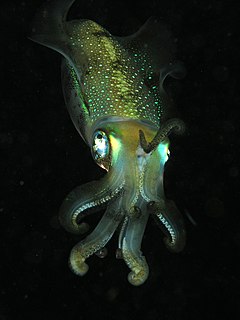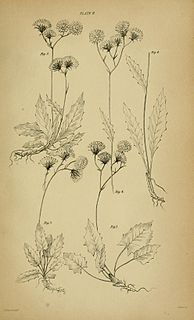
Malacology is the branch of invertebrate zoology that deals with the study of the Mollusca, the second-largest phylum of animals in terms of described species after the arthropods. Mollusks include snails and slugs, clams, octopuses and squid, and numerous other kinds, many of which have shells. One division of malacology, conchology, is devoted to the study of mollusk shells. Malacology derives from Greek μαλακός, malakos, "soft"; and -λογία, -logia.

James Dwight Dana FRS FRSE was an American geologist, mineralogist, volcanologist, and zoologist. He made pioneering studies of mountain-building, volcanic activity, and the origin and structure of continents and oceans around the world.

Nikolaus Joseph Freiherr von Jacquin was a scientist who studied medicine, chemistry and botany.

The Encyclopedia of Life (EOL) is a free, online encyclopedia intended to document all of the 1.9 million living species known to science. It is compiled from existing trusted databases curated by experts and with the assistance non-experts throughout the world. It aims to build one "infinitely expandable" page for each species, including video, sound, images, graphics, as well as text. In addition, the Encyclopedia incorporates content from the Biodiversity Heritage Library, which digitizes millions of pages of printed literature from the world's major natural history libraries. The project was initially backed by a US$50 million funding commitment, led by the MacArthur Foundation and the Sloan Foundation, who provided US$20 million and US$5 million, respectively. The additional US$25 million came from five cornerstone institutions—the Field Museum, Harvard University, the Marine Biological Laboratory, the Missouri Botanical Garden, and the Smithsonian Institution. The project was initially led by Jim Edwards and the development team by David Patterson. Today, participating institutions and individual donors continue to support EOL through financial contributions.

Symphyotrichum lateriflorum is a species of flowering plant in the aster family (Asteraceae). Commonly known as calico aster, starved aster, and white woodland aster, it is native to eastern and central North America. It is a perennial and herbaceous plant that may reach heights up to 120 centimeters and widths up to 30 cm (1 ft).

The Biodiversity Heritage Library for Europe (BHL-Europe) was a three-year (2009–2012) EU project aimed to the coordination of digitization of literature on biodiversity. It involved 28 major natural history museums, botanical gardens, libraries and other European institutions. BHL-Europe was founded in Berlin in May 2009 and regarded itself as a European partner project of the Biodiversity Heritage Library (BHL) project, which was founded in 2005 and initially formed by ten United States and British libraries.
Wendlandia psychotrioides is a species of shrubs or small trees, constituting part of the plant family Rubiaceae.
Hollandaea is a small genus of plants in the family Proteaceae containing four species of Australian rainforest trees. All four species are endemic to restricted areas of the Wet Tropics of northeast Queensland.
Canarium acutifolium is a forest tree species, of the plant family Burseraceae, growing naturally in New Guinea, the Moluccas, Sulawesi, New Britain, New Ireland, Bougainville and in lowland north-eastern Queensland, Australia.
Hollandaea sayeriana, sometimes named Sayer's silky oak, is a small species of Australian rainforest trees in the plant family Proteaceae.
Paronychia argyrocoma, the silvery nailwort, is a plant species native to the eastern United States. It has a disjunct distribution, found in New England and the Appalachian Mountains of the Southeast but not from New York, New Jersey or Pennsylvania in between. The species grows on rocky sites at elevations of 200–1800 m.

Catharine Johnston was an English botanical illustrator who had a species of marine animal named in her honour.
Adenophyllum wrightii is a North American species of flowering plants in the daisy family known by the common names San Felipe dogweed, San Felipe dyssodia and Wright's dogweed. It is native to Mexico and the US States of Arizona and New Mexico. The species was long thought to be extinct in New Mexico, but live populations were rediscovered in the state in 1999.

Ceropegia candelabrum is the type species in its genus of plants, belonging the subfamily Asclepiadoideae. The specific epithet is derived from the candelabra-like appearance of the inflorescences.
Neusticurus surinamensis, the red neusticurus, is a species of lizard in the family Gymnophthalmidae. It is native to Brazil.

Carditamera affinis is a species of marine bivalve mollusc. It was first described to science by George Brettingham Sowerby I in 1833. No English common name has been recorded for this species. The first appearance of this animal in the fossil record is 5.333 million years ago.

Siobhan Leachman is a New Zealand citizen scientist, open knowledge advocate, and Wikipedian whose work focusses on natural history.
Ceriodaphnia is a genus of the Daphniidae; the genus was described in 1853 by James Dwight Dana. It has cosmopolitan distribution.
Plantae Delavayanae: Plants from China collected in Yunnan by Father Delavay. is a book by Adrien René Franchet and Père Jean Marie Delavay, with Franchet describing and establishing the taxonomy for flora found by Delavay in Yunnan.










